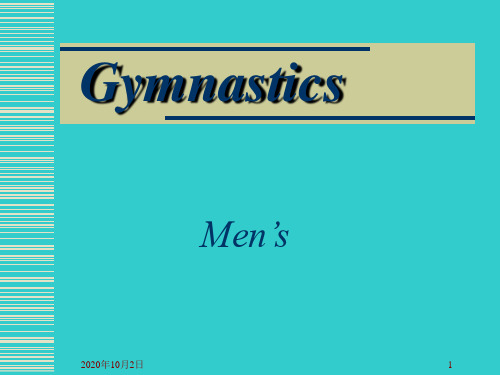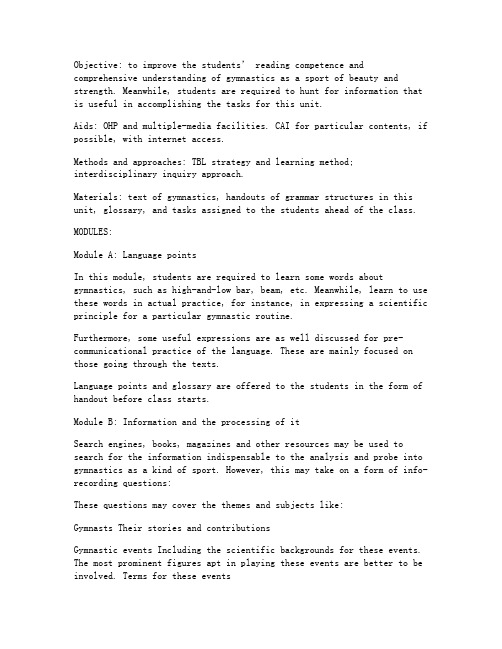Lesson34GYMNASTICS课件
- 格式:ppt
- 大小:3.79 MB
- 文档页数:25





高三Gymnastics(体操)一、教法建议【抛砖引玉】本单元同学们重点学习体操是一种高雅的体育健身运动,牢记在进行体操锻炼时的安全措施,如:独自一人地进行高低杠练习是危险的。
(It is dangerous to do body-building and exercises on a high bar and other pieces of equipment without others to help you .)开始训练前务必把手表、戒指或者项链取下来。
(Make sure you take off any watches , rings or necklaces before you start .)当你训练时最好穿紧身衣服,无领、无腰带,以免挂住器械。
(While you are doing gymnastics , you had better wear tight clothing without collars or belts so tha t it doesn‘t catch on any of the equipment .)另外要保重好身体,如果身体不适或者受伤时就停止练习。
( It is necessary for you to keep fit and take good care of yourself . Please stop practise doing gymnastics if you are unwell or have any injury .)观看精彩的体操表演是对美的享受。
在这一单元,同学们还要透彻地复习看病时的常用语 50 句,如:医生询问病情,病人诉说病情,诊断与治疗,开药与医嘱等。
(What’s your trouble ? = What‘s the matter with you ? = What’s wrong with you ? / It‘s nothing serious . / You’ll be all right very soon . / Take this medicine three times a day . / Drink plenty of water and have a goo d rest . … )主谓一致难点释疑,如:And 连接主语,谓语总是复数吗 ?众所周知,当 and 连接两个主语时,谓语常是复数。

Objective: to improve the students’ reading competence and comprehensive understanding of gymnastics as a sport of beauty and strength. Meanwhile, students are required to hunt for information that is useful in accomplishing the tasks for this unit.Aids: OHP and multiple-media facilities. CAI for particular contents, if possible, with internet access.Methods and approaches: TBL strategy and learning method; interdisciplinary inquiry approach.Materials: text of gymnastics, handouts of grammar structures in this unit, glossary, and tasks assigned to the students ahead of the class.MODULES:Module A: Language pointsIn this module, students are required to learn some words about gymnastics, such as high-and-low bar, beam, etc. Meanwhile, learn to use these words in actual practice, for instance, in expressing a scientific principle for a particular gymnastic routine.Furthermore, some useful expressions are as well discussed for pre-communicational practice of the language. These are mainly focused on those going through the texts.Language points and glossary are offered to the students in the form of handout before class starts.Module B: Information and the processing of itSearch engines, books, magazines and other resources may be used to search for the information indispensable to the analysis and probe into gymnastics as a kind of sport. However, this may take on a form of info-recording questions:These questions may cover the themes and subjects like:Gymnasts Their stories and contributionsGymnastic events Including the scientific backgrounds for these events. The most prominent figures apt in playing these events are better to be involved. Terms for these eventsStories of gymnastic games Funny stories. In open classes it is preferable to initiate a humorous air by telling funny stories with embodied language use. FLASH and other types of pictures may be exhibited so as to make the class more vivid.Specific questions may be delivered to the students before the open class so that they might do a pre-task information gathering. Besides, questions should be a result of the cooperation of both the teacher and the students.The processing of the information constitutes a major body of the class. Students exchange what they have turned up with each other and with the teacher. The teacher brings forth these results and encourages every one of the class to comment on them, trying to find a fair good solution to a certain task. Of course, if possible, groups of tasks ought to be framed into a project as such.Module C: PublicationThe module of publication can be seen as the outcome of the processing of information. This involves the learners’ ability to use the language in practical writing of specific themes, in this class, the comments and the understandings of tasks already delivered and conferred on. The writings may be considered as an extended task for the students to fulfill, yet publication is to some extent rather significant to ending the task circles of this class.Module D: InterdisciplineInterdisciplinary inquiry approach is the characteristics of such an open class. Nonetheless, how to interdisciplinize the subjects is somehow open to question. In this module, I shall sayinterdisciplinizing is a natural course that demands no instant intelligence. Only those who are adept at some particular subjects and who are also willing to amalgamate them in the light of pedagogical principles are titled to have a so-called interdisciplinary class. Regardless of this, interdisciplinary classes are aimed at under the circumstance of the New Curricula.Teaching procedures (in the disguise of tasks)Task One: a wholesome understanding of gymnasticsTeacher’s activities Students’ activities Remarks and commentsWhat does gymnastic belong to? (sports, arts, acting, etc)How many events of gymnastics can you think of? Give out the names.Where is the origin of modern gymnastics? Students read the text (Par. 1) and try to find some key words to the tasks on the left. They may also offer the information they’ve already searched for. Task that asks whether gymnastics is a kind of sports or arts may arouse a heat discussion. Encourage it.Task Two: Events of gymnasticsTeacher’s activities Students’ activities Remarks and commentsList all events that you have known about gymnastics, give them brief descriptions.Each event may have some persons apt at it. Say them. Step one: refer to the text and list all that is mentioned.Step two: give out their own materials. When depicting these events and personnel, students may come across difficulties of language forms.Allow them to use the mother tongue while encouraging them to express in English.Task Three: Gymnastics and scienceTeacher’s activities Students’ activities Remarks and commentsWhy should gymnasts be trained when they are still kids?Is it the bar that functions as the axis for the gymnast’s swingings?What is the relation between gym and dance? And gym and art? Students provide their versions of explanations while comparing them with one another. In this case, Chinese may be a preferable language in which these principles might be well articulated.Background:1. Boys and girls aged 18 months to 18 years are taught and trained. They learn the fundamental principles of gymnastics, while building confidence, strength, flexibility and creativity.2. 1、自由体操--Floor Exercise 2、鞍马--Pommel Horse 3、吊环--Rings 4、跳马--Vaulting Horse 5、双杠--Parallel Bars 6、单杠--Horizontal Bar 7、高低杠--Uneven Bars 8、平衡木--Balance Beam 9、助跳板--Spring board 10、跑道--Track 11、海绵坑--Sponge pit 12、镁粉--Chalk 13、护掌--Hand guard 14、体操鞋--Slippers 15、肋木--Rung 16、体操鞋--GYM shoes 17、松香--Resin 18、砂纸--Sand paper 19、保护带--Safety belt 20、体操馆--GYM hall 21、体操裤--GYM trousers 22、体操凳--GYM bench身体各部位(PARTS OF BODY)1、身体--Body2、手--Hand3、头--Head4、手指--Finger5、颈--Neck6、腕--Wrist7、眼--Eye8、肘--Balance Beam9、嘴--Mouth 10、背--back 11、耳--Ear 12、胸--Chest 13、肩--Shoulder 14、腰--Waist 15、臂--Arms 16、髋、臀--Hip 17、前臂--Forearm 18、腿--Leg 19、上臂--Upper arm 20、胫、小腿--Shank 21、脚--Foot 22、小腿肚--Calf 23、脚跟--Heel 24、膝--Knee 25、脚尖--Tiptoe 26、韧带--Tendon 27、下颚--Chin 28、蹲--Crouch 29、心脏--Heart 30、手背--Back of the hand 31、肌肉--Muscle 32、大腿--Thigh3. 关颖珊(Michelle Kwan): from a gymnast to a ballet dancer4. Gym and art: in ancient Greek, sports were regarded as a form of harmony with the Nature. Man goes in for sport for the purpose of linking himself to the harmonious nature.Task Four: Gymnastic stories(Sang Lan, former member of the national women's gymnastic team, suffered severe spinal injuries in a competition at the Goodwill Games held in Long Island in New York in the United States in 1998 and has been bound to a wheelchair ever since.)And what happened to her ever since? Was she fortunate enough to have access to high-end cures in the USA? What’s your comment?With regard to this, an extended task can be shaped: write an article titled ‘If I were Sang Lan’ and stimulate the students’ imagination while writing. They may seek any information possibly available from various resources before they start to write.Evaluation of the teaching1. While learning the expertise of gymnastics and its relationship with other branches such as science and art, students may have a backwash. Take heed of it.2. The extended task may be regarded as the homework assigned to the students. However, it should be underlined that the task cannot be accomplished only when the students are well engaged in the thought of the concept and stories of gymnastics, as well as Sang Lan’s legend which might have aroused only indifference in them.3. Language learning: can be realized through writing practice and grammar exercises respectively.Michelle Kwan started skating when she was 5 years old. She and hersister often went to the local skating rink after school to watch their brother play hockey, and they begged their parents to let them skate too. Once her parents gave her the green light to strap on the skates, Michelle started out by just playing around on the ice and says that she didn't get serious about the sport until she saw the Olympics. Then she got very serious. Michelle won her first skating competition at age 7, and by the time she was 15, she had won the American Ladies' National title. Her whole family encouraged her ambitions. When Michelle was 14, her parents sold their home in Torrance, California to pay skating expenses and moved into a one-bedroom cottage, where they lived for four years. Michelle held up her end of the deal. In 1998, she became thefirst female to record a perfect score of 6.0 at the U.S. Championships. Later that year, she won the silver medal at the Nagano Olympics. Her winning streak continued after Nagano. She won all 10 of thecompetitions she entered after the Olympics, but finally met her matchat the 1999 World Figure Skating Championships in Helsinki where shelost to Maria Butyrskaya. Undeterred, she is now making plans for the next Olympics. Michelle says that she always wears a Chinese good luck charm that her grandmother gave her and that she doesn't like to talktoo much before a performance. Instead, she prefers to focus, visualize her program, and warm up. Michelle will celebrate her 20th birthday on July 7.。
Gymnastics教学目标本单元主要词汇:ache; keep one’s balancedo body-building;at the doctor’s;require;lose one’s voice;do a handstand;a keep-fit programme;backward(s);be proud of ;hold a position steady;a length of wood ;glance;take/have a look at; follow safety measures; in all; gain;knock into sb;prepare…(sb。
) for; do a neat circle; cheer ;fall forward/over; be content with/to do; land neatly on the floor;highly;do sth。
to music 本单元的主要句型What can I do for you? There is something wrong with…?Where does it hurt? My …hurt/I hurt my…I’ve got a temperature。
Let me take a look at it/ you。
Do this treatment twice a day for a week? Take this medicine/two pills three times a day。
Wht seems to be the matter? 10。
It’ll /You’ll be all right/ well/ better soon。
It is /was + 被强调部分+ who/that …教学建议重点掌握本单元出现的与体操相关联的一些词组和短语。
运用所学语言,围绕体操这一题材,完成教材和练习册中所要求的有关听说读写方面的任务。